“Why not?” Those words make up one of the most powerful rhetorical questions in the English language.
Ersel Evans, the late nuclear visionary and my great friend, was famous for tackling difficult problems by saying, “Why not?” When he retired, his staff at the Department of Energy’s Hanford Site presented him with a video of many circumstances where he dealt with a challenge and a new course of action with his signature phrase.
Why not is often the necessary question to overhaul orthodoxy when orthodoxy has become rigid and exclusionary. Dr. Ronald Pinkel, the first medical director and CEO of St. Jude Children’s Research Hospital in Memphis, confronted childhood leukemia in 1962, then considered a painful end to a short life. At that time five drugs were given sequentially to children with leukemia, and they sometimes prolonged life.
Pinkel’s solution: Why not administer all five drugs at the same time? Orthodoxy said each of these drugs was a powerful poison and might kill the child. His answer was that doctors knew the child would die anyway, so why not try something radical? It worked and using a drug “cocktail” is the basis of treating many diseases nowadays, from AIDS to childhood cancers.
Medicine is often the victim of its orthodoxies. Once procedures and approaches are established, it is hard to divert practitioners from these courses of action.
Take COVID-19. It is now treated with antiviral drugs and steroids. Patients with severe pneumonia — for that is what develops — are put on ventilators and given oxygen. That is a long and expensive procedure that leaves a trail of damage to the lungs, heart, and possibly to the immune system.
But there is a wondrous way of treating the inflammation, which is the killer with COVID-19 pneumonia. It is low-dose radiation therapy (LDRT) — about one-eightieth of the dose for cancer, according to Dr. James S. Welsh, a radiation oncologist at Loyola University Medical Center and the Edward Hines, Jr. Veterans Affairs Hospital, and a former president of the American College of Radiation Oncology. A devout proponent of LDRT, Welsh thinks it is only preconceived concerns about radiation and a fear of it that keeps this valuable therapy from saving lives.
He, along with Jerry Cuttler, a veteran Canadian nuclear scientist, point to a time 70 years ago when viral pneumonia was routinely cured with LDRT. There is a trove of cohort information about the effectiveness of this treatment. It can be accessed on the web. Go look it up.
India is currently facing one of the greatest health crises any country has seen in modern times. COVID-19 may yet rival the plagues of old in its lethality in India.
So why not try low-dose radiation to save the lives of those lucky enough to make it to an Indian hospital? If administered in time, research shows it arrests the cytokine storm, which is the inflammation that kills COVID-19 patients.
The treatment is known in India. I have read a study on the use of low-dose radiation to treat COVID-19 patients in India, conducted last year by Dr. Kanika Sood Sharma of Dharamshila Narayana Superspecialty Hospital in Delhi and her research team. The study involved 10 patients with moderate-to-severe COVID-19 who were treated with low-dose radiation. “All patients completed the prescribed treatment. Nine patients had a complete clinical recovery, mostly within 3-7 days. One patient, who was a known hypertensive, showed clinical deterioration and died 24 days after LDRT,” Dr. Sharma said in the study, which was released last August.
The results of this small study are incredibly encouraging, especially if considered with other studies and with the history of using low-dose radiation to treat pneumonia before antibiotics supplanted it.
If India would just grasp this technology (most hospitals can use their existing radiation equipment), they might save hundreds to many thousands of lives.
Cuttler and others believe that using low-dose radiation to treat COVID-19 could lead the way to its use as a treatment for arthritis and Alzheimer’s. Why not? It works, Cuttler says.

 Follow
Follow
Leave a Reply